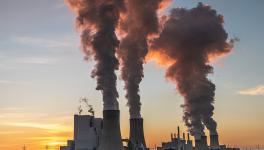Anthropogenic Sulphur Aerosols may not Reduce Global Warming as Thought

Anthropogenic or manufactured aerosols are thought to have a cooling effect, and that’s why they can reduce global warming resulting from greenhouse gases. One of the essential aerosols is Sulphur, which produces a cooling effect by reflecting sunlight into space and modifying clouds.
Aerosols are microscopic solid particles or tiny liquid droplets suspended in the air. Sulphur aerosols which can confer a cooling effect are sulphate aerosols. These sulphate aerosols are present in the air as liquid droplets or even partly crystallised. The sulphate aerosols emanate from sulphate emissions from anthropogenic activities or natural sources. The primary source of sulphate aerosols is the production of Sulphur dioxide (a Sulphur compound), which is produced from burning fossil fuels, along with a minor contribution from burning biomass (in the context of ecology, biomass indicates the living organisms like plants and animals). The natural sources of sulphate aerosols are marine phytoplankton as well as the emission of Sulphur dioxide from volcanic eruptions.
Volcanic eruptions are known to cause dramatic shifts in climate, especially when they erupt. Even when the volcanoes are in dormancy, they can release Sulphur. They can release more Sulphur when dormant than had been thought earlier. A new study published in the journal Geophysical Research Letters suggests that scientists have been undermining sulphate emission from the ono-eruptive or dormant volcanoes. This, the study suggests, could lead to inaccuracies in climate projections in future. Remember, sulphate aerosols contribute to the cooling of the atmosphere. If the estimation regarding this significant aerosol goes wrong, then that can impact the projections.
The new study emphasises the abundance of sulphate aerosols in the pre-industrial period. The main motive behind it is that if sulphate aerosols were found in abundance in the pre-industrial period, then manufactured sources of sulphate aerosols would have a small contribution to cooling the environment. On the other hand, if the pre-industrial level of the aerosols were minuscule, then anthropogenic sulphate aerosols would have a sizeable cooling effect. Paris Agreement also aims to limit the global warming rate compared with the pre-industrial temperature.
“The amount of cooling depends on how abundant sulphate aerosols were in the atmosphere before humans started burning fossil fuels,” commented Ursula Jongebloed, the first author of the study.
Experts opine that the study is interesting as it tries to estimate the pre-industrial aerosol and argues that underestimating the emissions from that period will lead to an overestimation of the cooling effect by sulphate aerosols produced from anthropogenic activities.
It has been estimated that nearly 60% of the manufactured warming in the Arctic region has been nullified by sulphate aerosols emanating from anthropogenic activities. Notably, the Arctic is warming at a rate four times faster than the average global warming.
The researchers of the study considered the ice cores in Greenland, which have records of emissions from North America, Europe and some other surrounding oceans. They studied the ice core layers and estimated the level of sulphate aerosols in the period 1200-1850. Their estimation revealed that inactive volcanoes release up to thrice the rate of sulphate emissions that was thought earlier.
The new results can have profound implications for climate models.
“Current models underestimate volcanic sulphur emissions from passive degassing (non-eruptive volcanoes) during the pre-industrial era,” Jongebloed remarked in a statement.
The researchers also found that the higher level of emissions in the pre-industrial period reduced aerosol cooling in the Arctic by a factor of two, as calculated by climate models.
“We found that on longer timescales, the amount of sulfate aerosols released during passive degassing is much higher than during eruptions. Passive degassing releases at least 10 times more sulfur into the atmosphere, on decadal timescales, than eruptions, and it could be as much as 30 times more,” Jongebloed said.
Notably, inactive volcanoes release hydrogen sulphide, which eventually forms sulphur dioxide and sulphate aerosols. Previously, scientists thought hydrogen sulphide contributes less than 1% to the overall sulphur concentration in the atmosphere. The new study also estimates hydrogen sulphide emissions from volcanoes which could have significantly contributed to the atmospheric sulphate in the pre-industrial period.
So the new study opens up possibilities for further investigation on sulphate aerosols and the contribution of anthropogenic factors such as industries and fossil fuel burning and natural sources like volcanoes and marine phytoplankton. According to the researchers, this will bolster future climate models and predictions.
Get the latest reports & analysis with people's perspective on Protests, movements & deep analytical videos, discussions of the current affairs in your Telegram app. Subscribe to NewsClick's Telegram channel & get Real-Time updates on stories, as they get published on our website.















